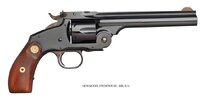You are using an out of date browser. It may not display this or other websites correctly.
You should upgrade or use an alternative browser.
You should upgrade or use an alternative browser.
Would You Schofield?
- Thread starter Mark_Mark
- Start date
halfmoonclip
Member
- Joined
- Feb 4, 2011
- Messages
- 2,768
Tell us more. Is this stuff, or its residue, hydroscopic? Can it be loaded and handled like smokeless?Black M-Z powder
First I've heard of it.
Moon
halfmoonclip
Member
- Joined
- Feb 4, 2011
- Messages
- 2,768
Driftwood, what was the purpose of the of the spur on the trigger guard?This is the Russian model, specifically a 2nd Model Russian. Notice the big, pointy hump on the grip that I mentioned in an earlier post. Notice too the spur on the bottom of the trigger guard, although it was sometimes sawed off. And a few New Model Number Threes had the spur on the trigger guard. The identifying feature is the big hump on the grip.
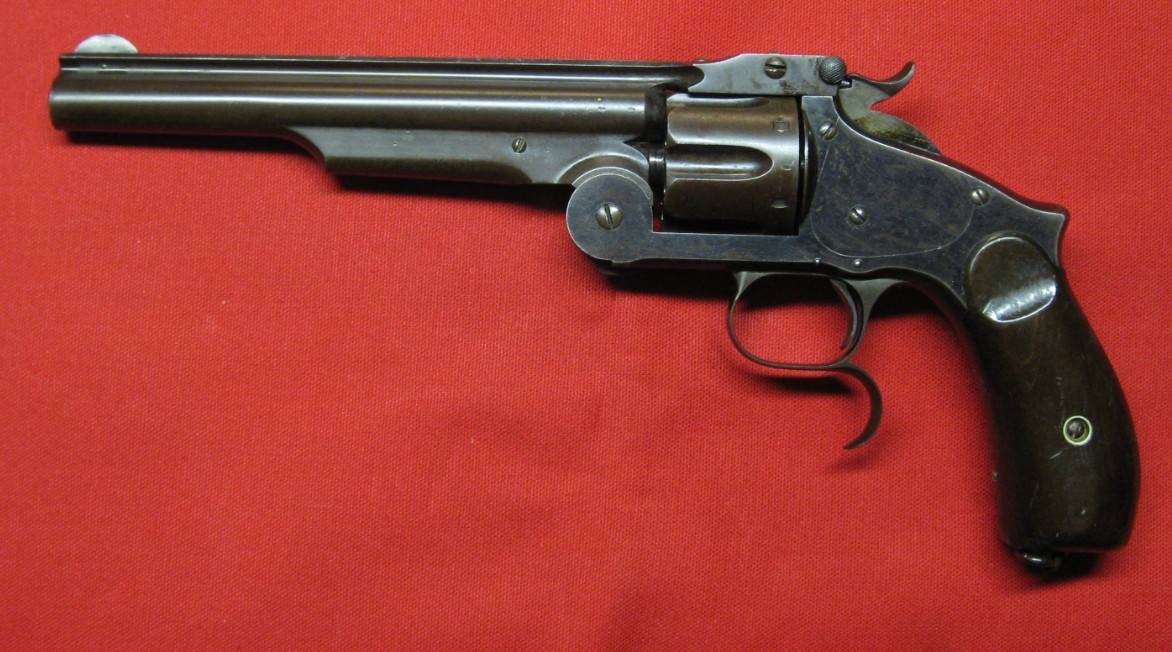
Moon
Driftwood Johnson
Member
There are several theories behind the spur on the trigger guard of the Russian model.Driftwood, what was the purpose of the of the spur on the trigger guard?
Moon
Some say it is a good place to rest your index finger while firing the revolver. I have tried that, and that does not work for me. I grip the Russian model just like any other single action revolver.
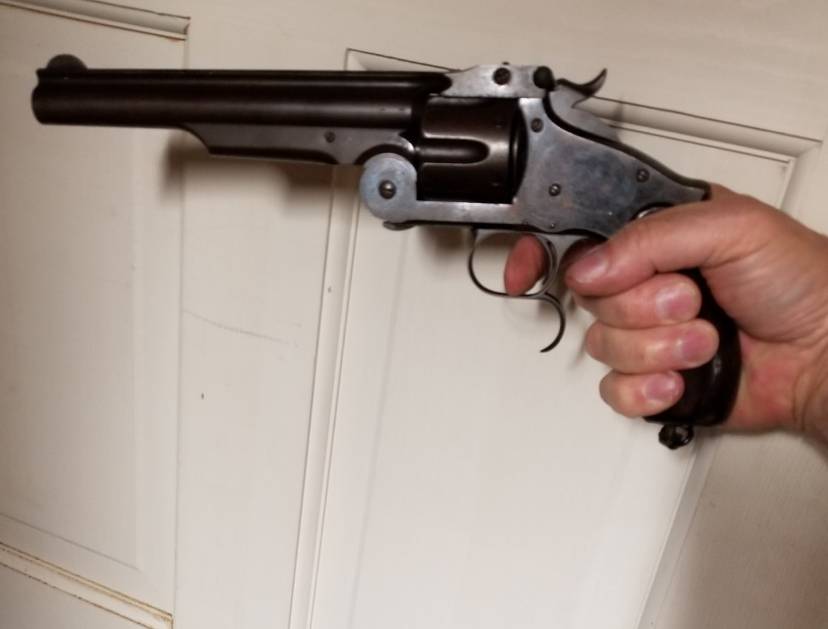
As I stated earlier, all #3 Smith and Wesson revolvers have the hammer placed further forward of the grip than a Colt. Consequently in order to reach the hammer spur, I have to reposition my hand to reach the hammer spur with my thumb. Notice in doing so the pointy part of the grip (called the Knuckle) is in direct contact with the palm of my hand. If I were to fire the revolver with this grip, the pointy part of the grip would dig into my hand in recoil, and it would hurt. Trust me on this.
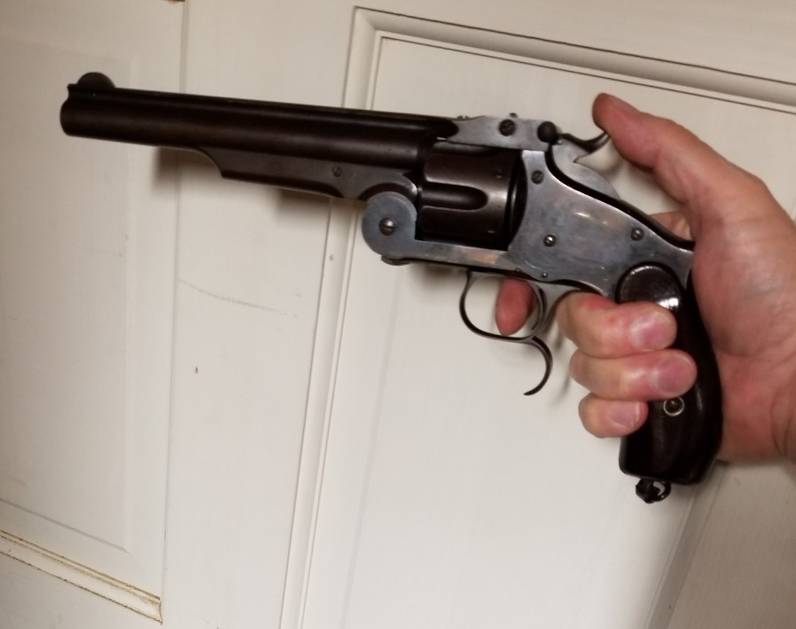
So to shoot the Russian model I have to reposition my hand again to get my palm below the knuckle of the grip. Notice in none of these photos am I touching the trigger guard spur.
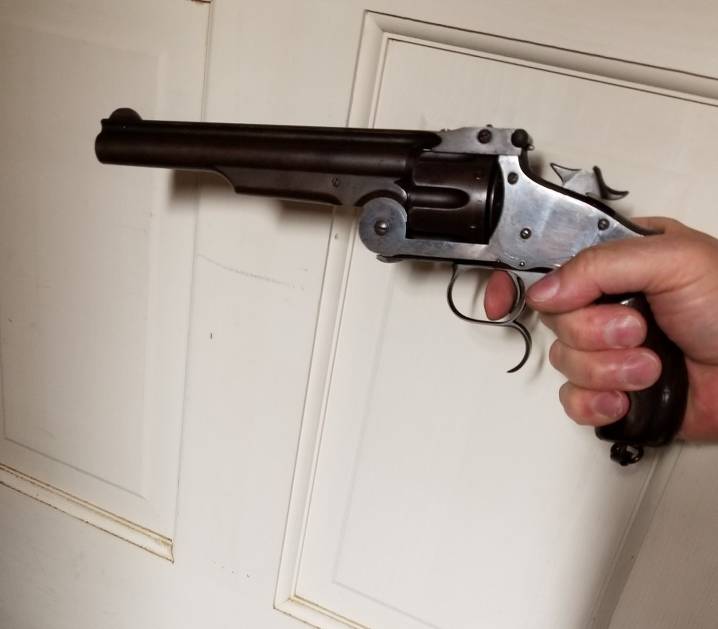
Another reason sometimes given for the trigger guard spur on the Russian model is to hang it from a belt or sash. Like this guy.
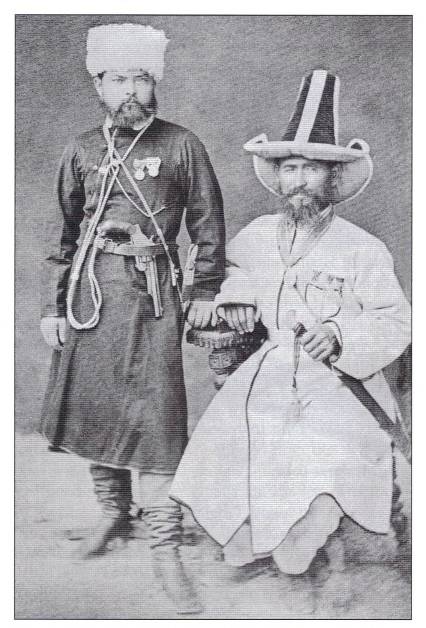
I really do not know how typical that is, this guy was the body guard for a local Russian noble. I have no idea if the Russian cavalry had holsters for their revolvers, I suspect they did, or if they hung them from a belt. It does not look very secure.
Finally, my own opinion is it was just an embellishment the Russians wanted, with no practical use at all. There were other European revolvers that had trigger guard spurs on them..
In point of fact, many trigger guard spurs were sawed of the revolvers when they made it to the American West.
Also, I have seen New Model Number Three revolvers with the same trigger guard spurs on them. A bit unusual, but not unheard of.
The pointy grip knuckle was a specific requirement of the Russian government, to prevent the revolver from rolling in the hand in recoil, which it does very well.
Just going through some old photos I came across this photo of a range session with my Russian Model.
Fired with 44 Russian ammo loaded with Black Powder. Notice the revolver is still sooty from the Black Powder.
In truth, I do not much like shooting my Russian model, I think I have said that before, because the knuckle makes shooting so awkward. I much prefer shooting a New Model Number Three.
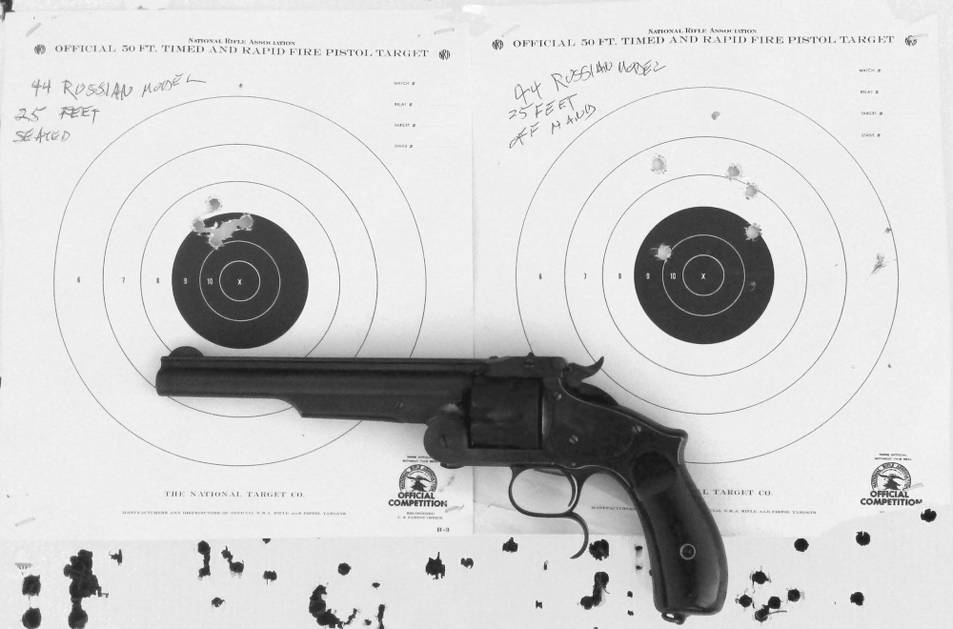
halfmoonclip
Member
- Joined
- Feb 4, 2011
- Messages
- 2,768
Thanks, Driftwood. All that makes sense; the Smiths are an adjustment after the more familiar SAA.
When we were kids, we put a finger on it on our cap guns.
Someone speculated that it might be a guard, if using the handgun to parry a saber blow.
Thinking out loud here, it is amazing the ergonomic missteps arms makers followed, and just how right some others got it...Browning for one.
Moon
When we were kids, we put a finger on it on our cap guns.
Someone speculated that it might be a guard, if using the handgun to parry a saber blow.
Thinking out loud here, it is amazing the ergonomic missteps arms makers followed, and just how right some others got it...Browning for one.
Moon
CajunBass
Member
I got one of those too. A COVID project I got into when I couldn't get to the gunstore..or rather could't get INTO the gun store. Kind of a cheap gun collection. Guns I knew I'd never actually spring real money for.I got one of the Colt/Umarex air pistols. I like that the length of the CO2 cartridge necessitated an 1860 grip frame.
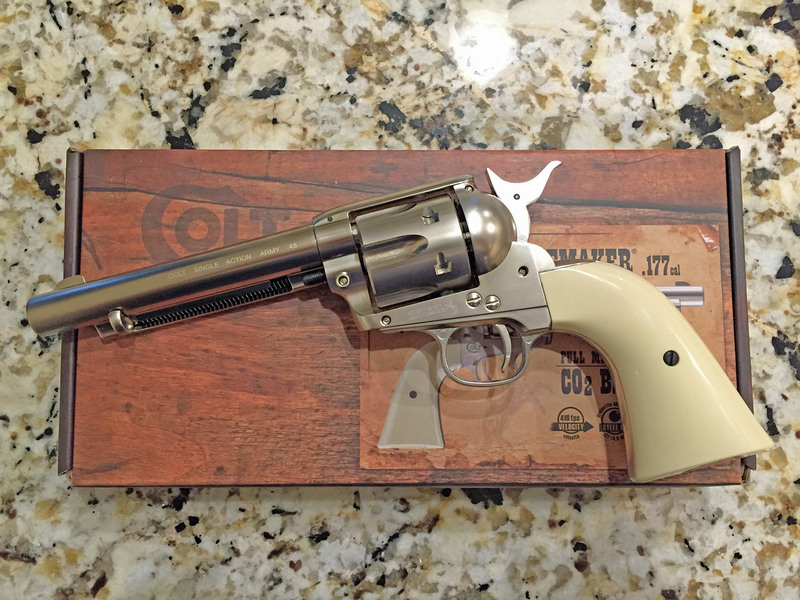
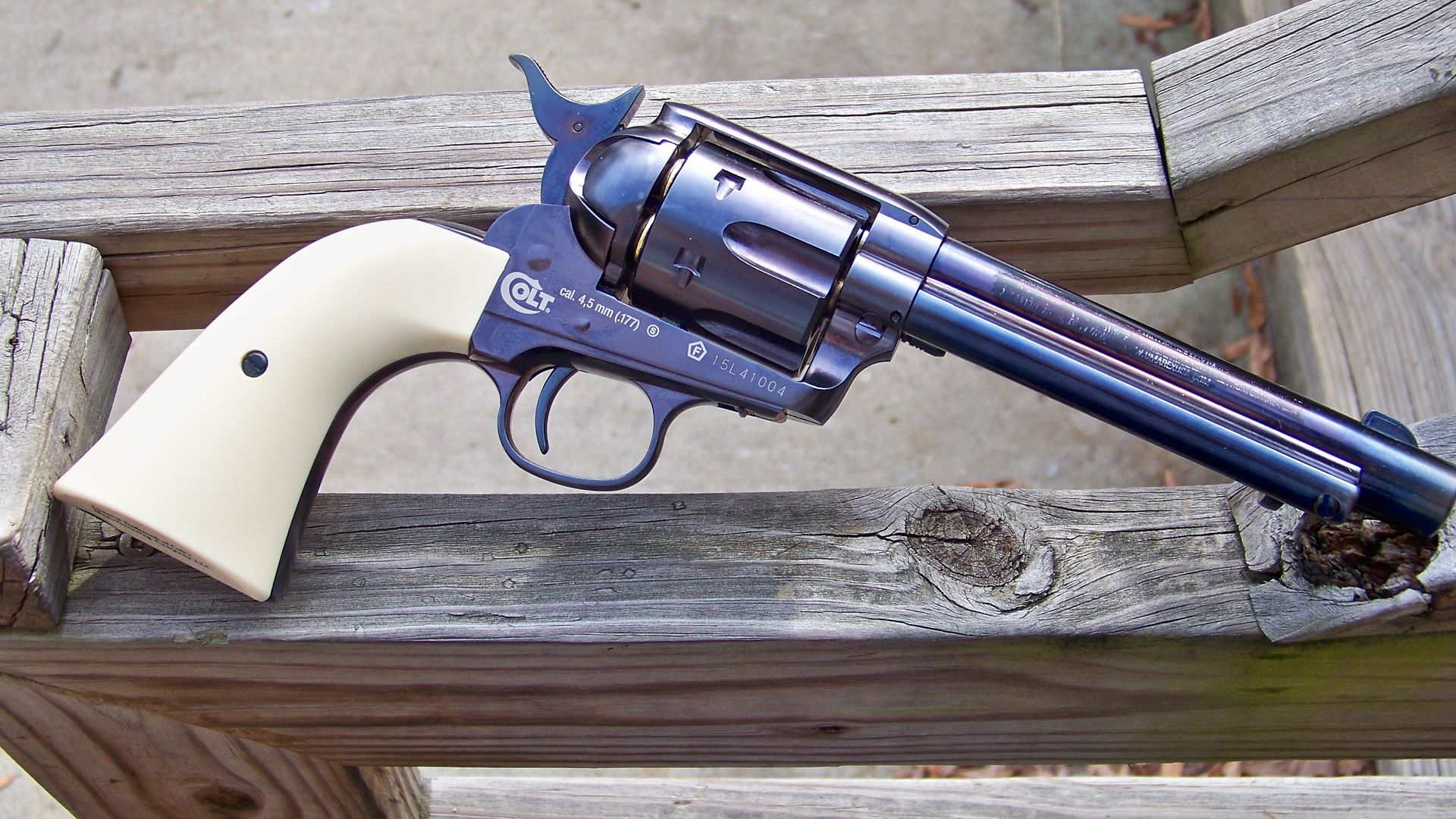
l like the 1860 grip also,
Driftwood Johnson
Member
Thanks, Driftwood. All that makes sense; the Smiths are an adjustment after the more familiar SAA.
When we were kids, we put a finger on it on our cap guns.
Someone speculated that it might be a guard, if using the handgun to parry a saber blow.
Thinking out loud here, it is amazing the ergonomic missteps arms makers followed, and just how right some others got it...Browning for one.
Moon
Yes, I forgot the theory about parrying a sabre blow. I don't give that one much credit, I still think the trigger guard spur was just a design affectation.
Regarding 'ergonomic missteps' don't be too hard on Smith and Wesson. Don't forget, the pointed knuckle and the trigger guard spur were specific features required by the Russians.
I forget all the details, but a relative of the Tsar accompanied Buffalo Bill on a 'hunting expedition' in the early 1870s. He was very impressed with what we call today the American model, which was the first large frame, #3 Top Break revolver being manufactured at the time. Based on his recommendation, S&W obtained a contract for 20,000 revolvers from the Russian government. These are variously known as the First Model Russian, or the Old, Old Model Russian. Physically this model was pretty much identical to the American model, with the only major change being chambering it for what came to be known as the 44 Russian cartridge. The previous American model had been chambered for a cartridge that came to be known as 44 American which employed an outside lubricated, heeled bullet, much like we see on modern 22 Rimfire ammunition. (A few American models were chambered for 44 Henry Rimfire). The 44 Russian cartridge carried a smaller diameter bullet, .429 in diameter if I recall correctly. Although some sources say the early 44 Russian cartridges were outside lubricated, the idea was that the bullet would carry lube grooves inside the brass case, so outside lube did not pick up contamination.
This is a photo of my 1st Model Russian. The barrel has been chopped down, an old coin has been substituted for the front sight, it wears some funky modern grips, and it has been polished down into the white, all of which made it affordable to me. Typically 1st Model Russians go for big money. As I said earlier, this model is visually identical to the American model, the only difference being the chambering.
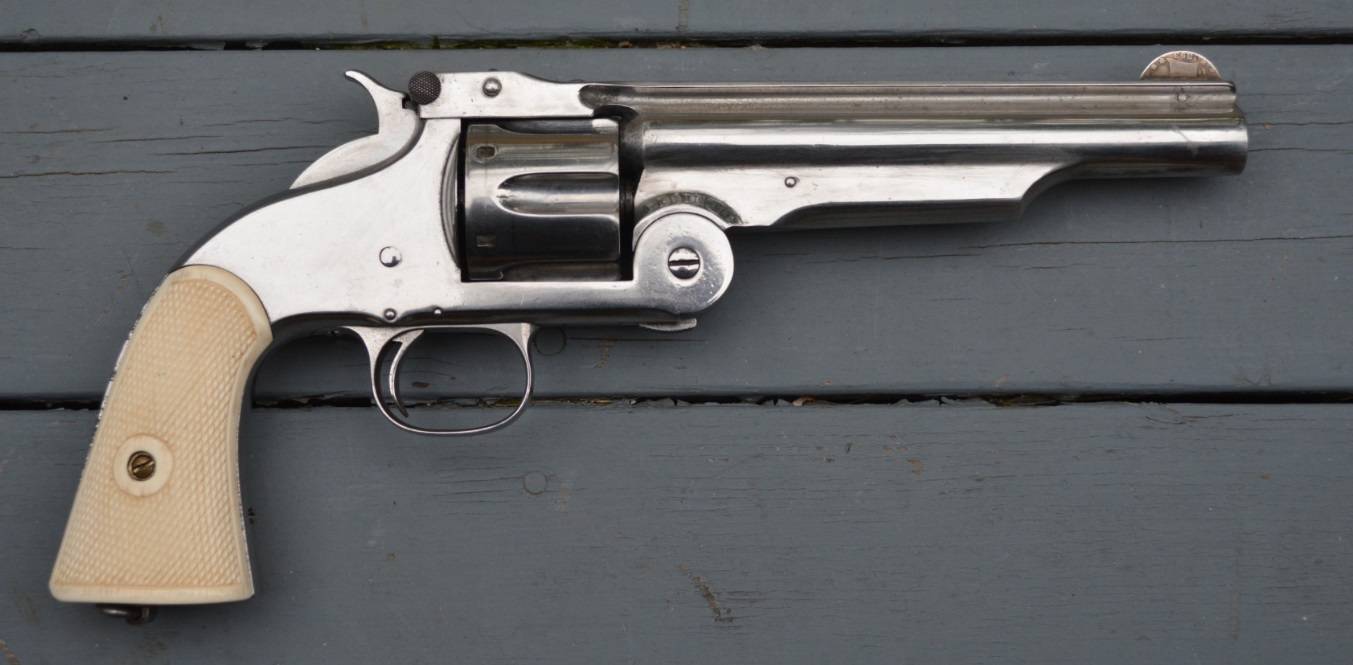
Here is my 1st Model Russian broken open with some of my Black Powder 44 Russian ammo.
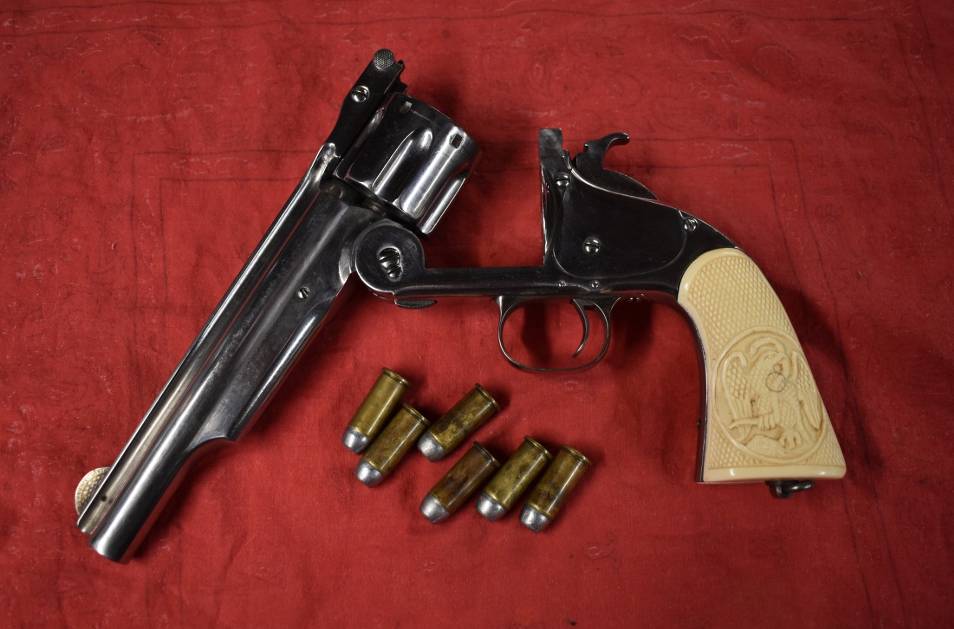
In 1873 Smith and Wesson signed the 'second contract' with the Russians, and sold them approximately 85,000 revolvers, ending production of the 2nd Model in 1878. This is when the changes required by the Russians kicked in. Here is a photo of my 2nd Model Russian, which shipped in 1875, with some antique 44 Russian rounds. Note the radically different grip shape, as well as the spur on the trigger guard.
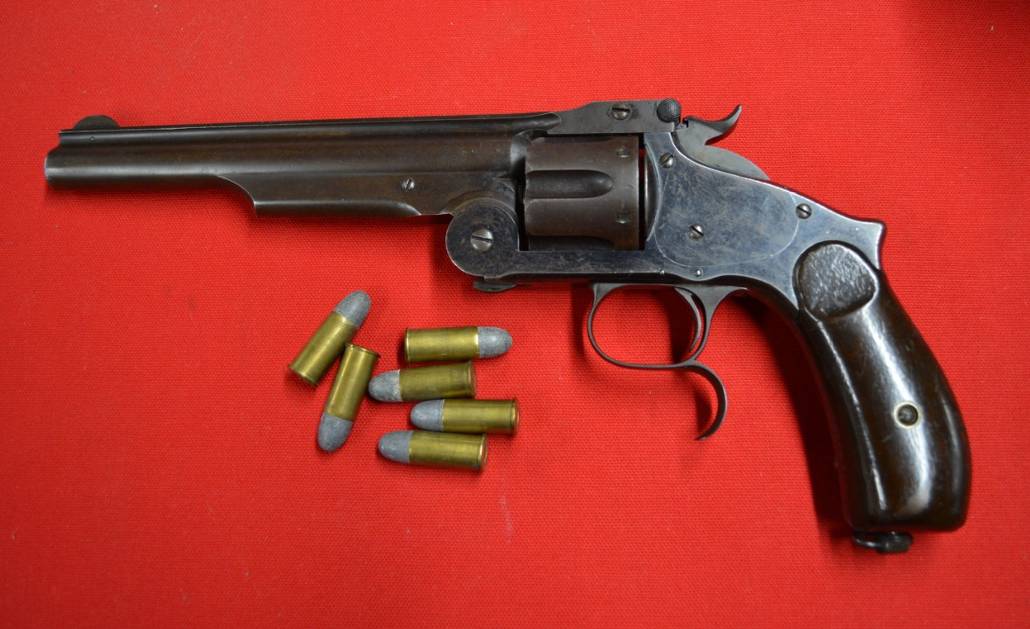
Smith and Wesson signed a third contract with the Russians in 1874, selling them another 13,500 revolvers. Production of all Russian models ceased in 1878. The only physical difference between the 2nd Model Russians and the 3rd Model Russians was a large, knurled thumb screw at the top of the top strap on the 3rd Model, which made disassembly easier. If you google the 'Russian' model revolvers being made by Uberti, you will see they are all copies of the 3rd models, with the large thumbscrew on the top strap.
Anyway, with additional sales to Turkey and Japan, Smith and Wesson eventually produced about 150,000 Russian models of all three models. Far more than any of the other large frame #3 Top Breaks. So I would not call the awkwardness of the Russian models a misstep, S&W was providing what the customer wanted.
But it is interesting to note that when the New Model Number Three came out in 1878, the same year Russian production ceased, the awkward grip of the Russian model grips became a thing of the past.
Driftwood Johnson
Member
Thank you Driftwood for marvelous posts and pictures in them!
Would you have Beretta Laramie or Uberti New Model N°3 (I believe we are talking about the same revolver under two different model codes)?
View attachment 1195613
How that one handles when compared with other top break revolvers you listed?
The Beretta Laramie or the Uberti New Model Number Three, are modern copies of the Smith and Wesson New Model Number Three. I have no idea if they are still being imported. (Uberti is owned by Beretta, hence the different model codes.)
I do not have either of these revolvers, however I have two original S&W New Model Number Threes.
I'm pretty sure I posted photos of them earlier, but what the heck, here they are again. The blued one left shipped in 1896 and was part of a large shipment to Japan. Interesting to speculate how it got back in the USA, perhaps in a GI's duffle returning from WWII. Just a guess. I bought it from a dealer a few years ago, and he said he bought it from a dealer. So other than being shipped to Japan that is all I know about it. The nickel plated one shipped in 1882, then was refinished at the factory in 1965. This is the one I mistook for a Schofield in an earlier discussion. I do have a factory letter for it.
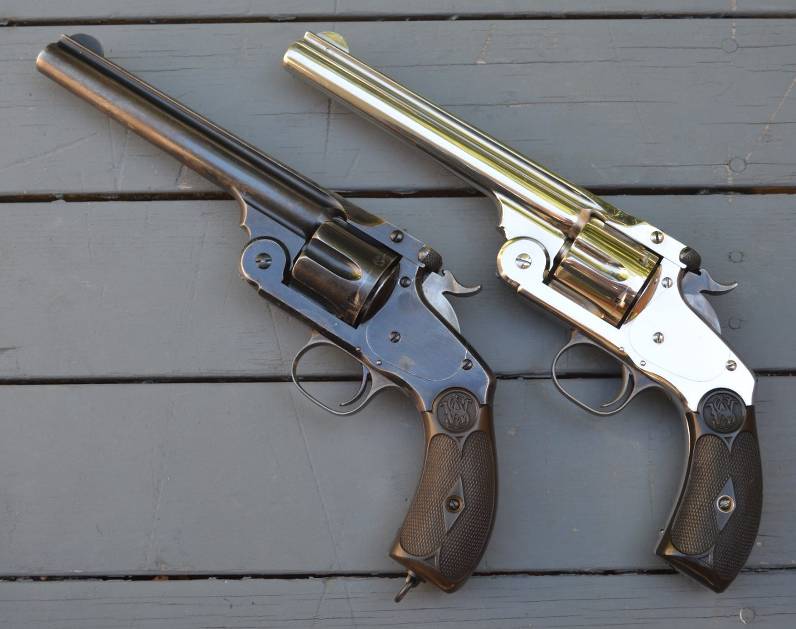
Anyway, you can see the shape of the modern replicas are very similar to the original New Model Number Three. A couple of differences: the modern replicas have a windage adjustable rear sight. Although the NMN3 was available with a windage adjustable rear sight, it usually accompanied a taller front sight. Also, if you look carefully at the modern replicas you will see they incorporate a knurled thumb screw on the top strap, much like a 3rd Model Russian, which leads me to believe Uberti is using the same barrel assembly for their Russian revolvers and the modern replicas of the New Model Number Three.
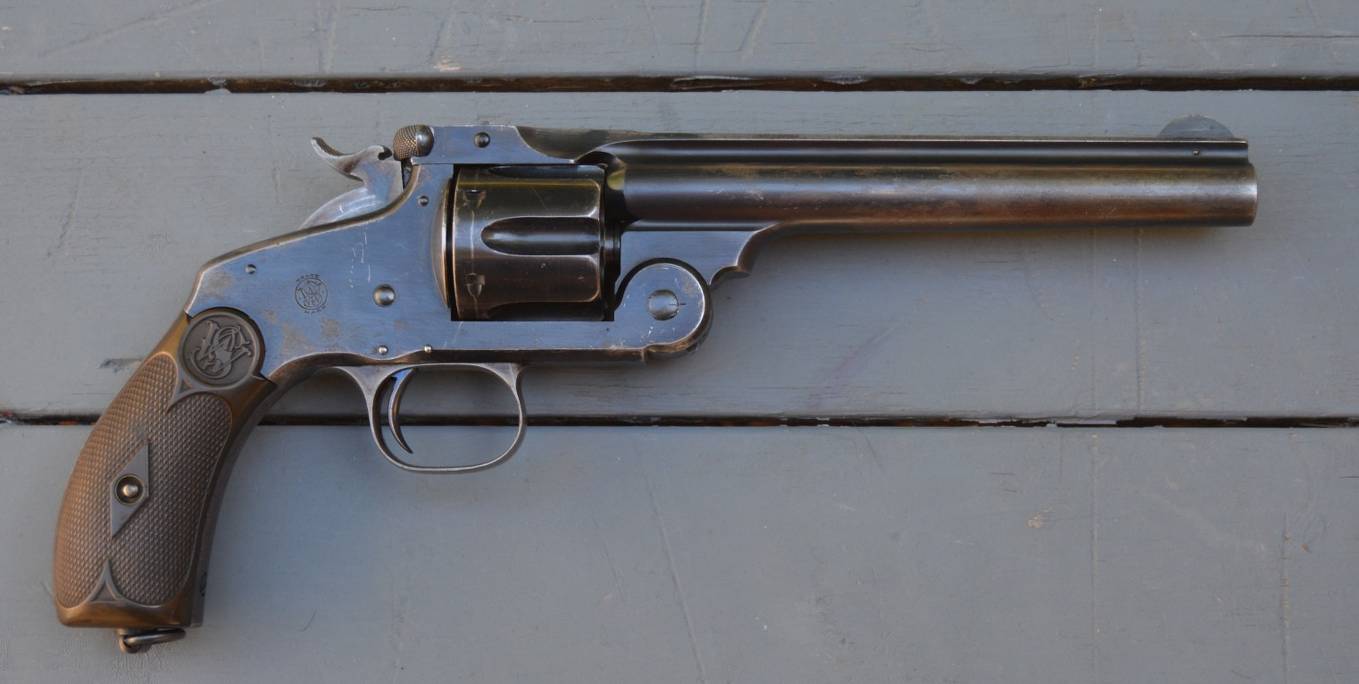
I am still kicking myself for not buying this target model New Model Number Three. Note the tall front sight. I was given first refusal and passed, like an idiot. This one is chambered for the unusual S&W 38-44 target cartridge, not to be confused with the later 38-44 double action cartridge. Much to my chagrin I found out later that this target model could also fire 38S&W cartridges. Not 38 Special, 38S&W. Anyway I am still kicking myself for not grabbing it because the asking price was very reasonable.
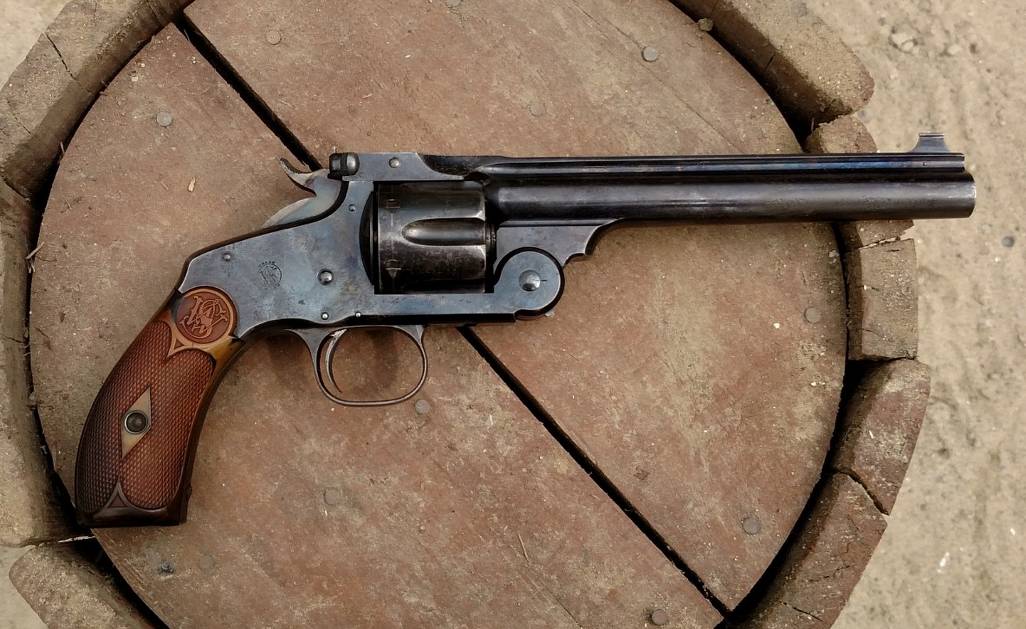
Anyway.........
You asked how these revolvers handle.
Very well. Much better than the Russian models with its awkward grip, and I think they handle better than the Schofields too. Personal opinion.
Just like any #3 Top Break, the hammer is positioned farther forward than on a Colt, so it is still a stretch to reach it. With my pinky under the grip I cannot quite reach the hammer spur. It does not help that all hammer spurs on all #3 Top Breaks point up slightly.
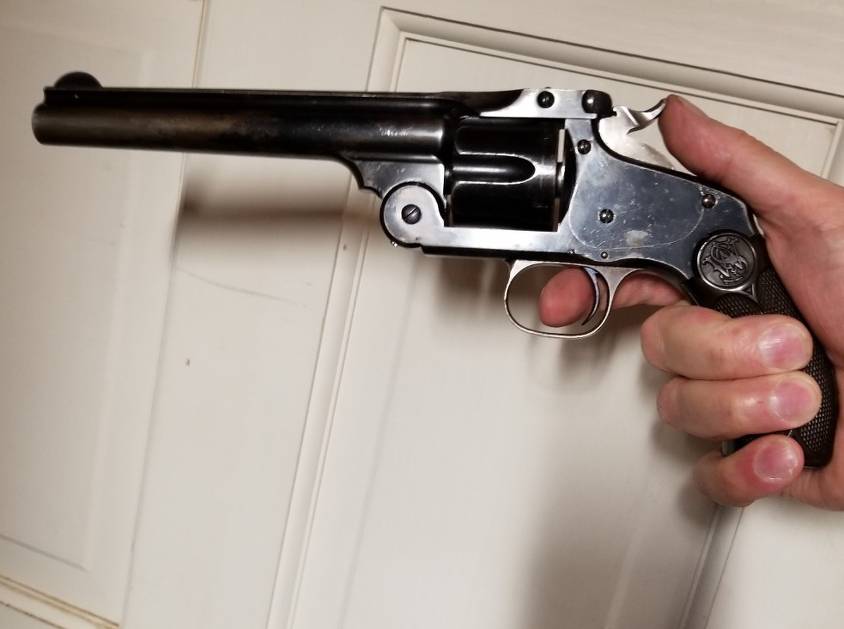
If I do not curl my pinky under the grip, I can reach the hammer just fine.
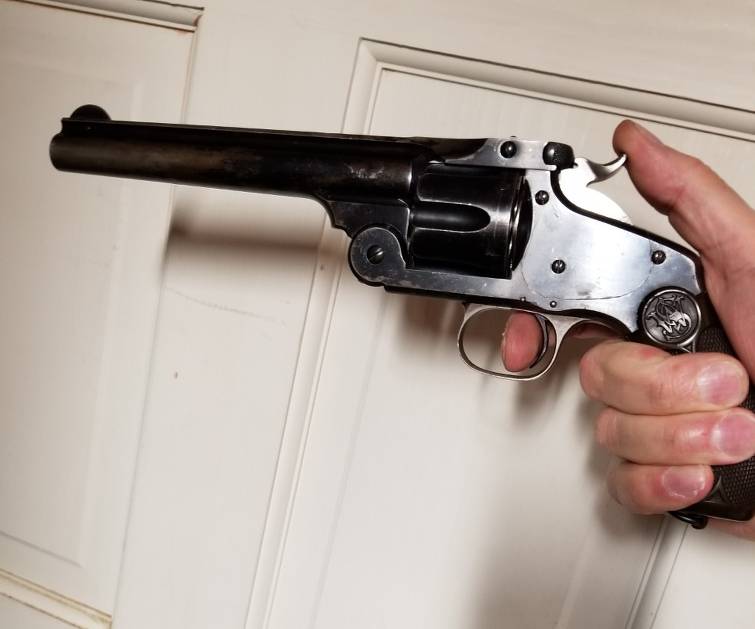
That is the way I usually shoot this model.
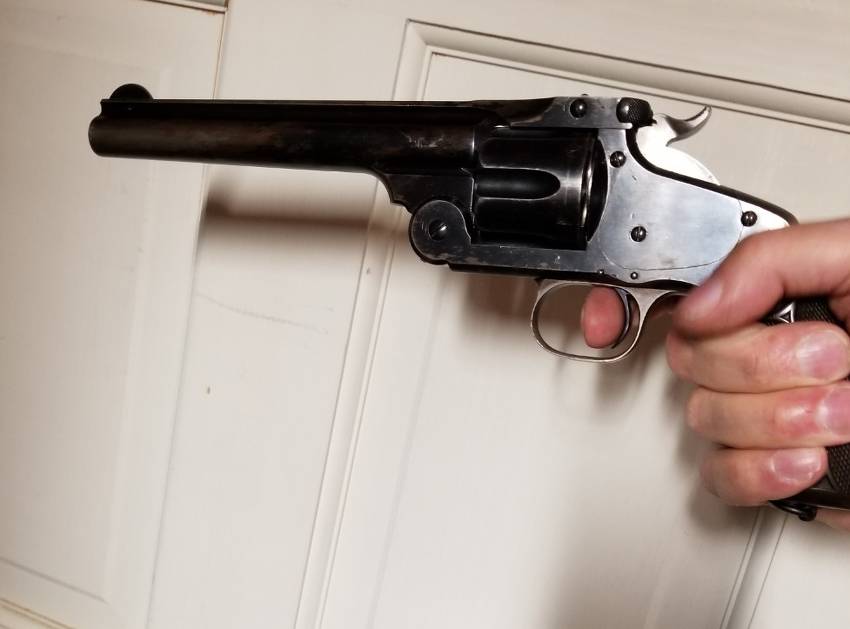
Again, these are not Colts, they do feel different. I only shoot my New Model Number Threes with 44 Russian ammo loaded with Black Powder. The recoil is milder than a fully loaded Black Powder 45 Colt. I do allow the grip to rotated slightly in my hand in recoil, then I regrip for the next shot. I usually bring my NM#3s to a CAS match once a year. The other thing about these revolvers is they all tend to shoot high, because the front sight is so low. I have to remember to hold low on the target, or the shot may go right over the top of the steel plate.
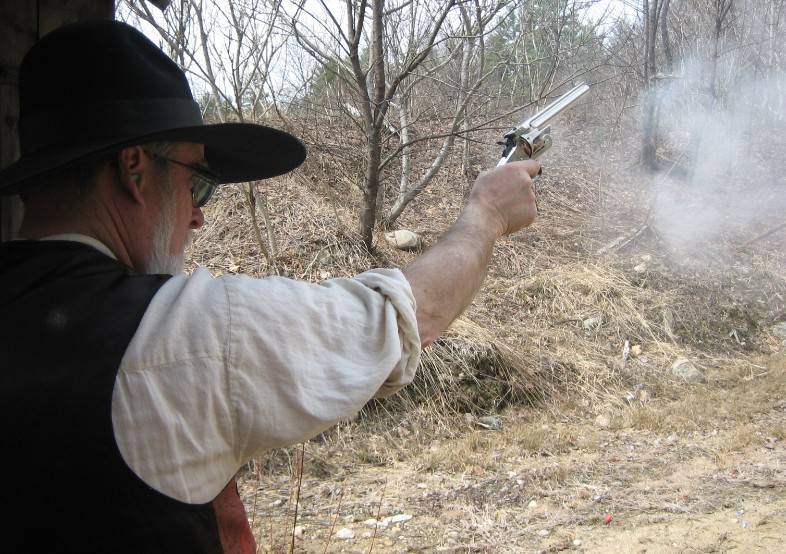
P.S. I suspect the modern replicas will not do well with Black Powder because of the reduction of the gas collar at the front of the cylinder. See my earlier remarks about this.
Last edited:
halfmoonclip
Member
- Joined
- Feb 4, 2011
- Messages
- 2,768
Actually, I was thinking more about things like the Mauser Broomhandle, or even the Brit autos with their nearly 90* grip angle. Not really throwing stones here; ergonomics wasn't even a smile on anyone's face back then. A whole lot of things were just being figured out as they went along.Yes, I forgot the theory about parrying a sabre blow. I don't give that one much credit, I still think the trigger guard spur was just a design affectation.
Regarding 'ergonomic missteps' don't be too hard on Smith and Wesson. Don't forget, the pointed knuckle and the trigger guard spur were specific features required by the Russians.
I forget all the details, but a relative of the Tsar accompanied Buffalo Bill on a 'hunting expedition' in the early 1870s. He was very impressed with what we call today the American model, which was the first large frame, #3 Top Break revolver being manufactured at the time. Based on his recommendation, S&W obtained a contract for 20,000 revolvers from the Russian government. These are variously known as the First Model Russian, or the Old, Old Model Russian. Physically this model was pretty much identical to the American model, with the only major change being chambering it for what came to be known as the 44 Russian cartridge. The previous American model had been chambered for a cartridge that came to be known as 44 American which employed an outside lubricated, heeled bullet, much like we see on modern 22 Rimfire ammunition. (A few American models were chambered for 44 Henry Rimfire). The 44 Russian cartridge carried a smaller diameter bullet, .429 in diameter if I recall correctly. Although some sources say the early 44 Russian cartridges were outside lubricated, the idea was that the bullet would carry lube grooves inside the brass case, so outside lube did not pick up contamination.
This is a photo of my 1st Model Russian. The barrel has been chopped down, an old coin has been substituted for the front sight, it wears some funky modern grips, and it has been polished down into the white, all of which made it affordable to me. Typically 1st Model Russians go for big money. As I said earlier, this model is visually identical to the American model, the only difference being the chambering.

Here is my 1st Model Russian broken open with some of my Black Powder 44 Russian ammo.

In 1873 Smith and Wesson signed the 'second contract' with the Russians, and sold them approximately 85,000 revolvers, ending production of the 2nd Model in 1878. This is when the changes required by the Russians kicked in. Here is a photo of my 2nd Model Russian, which shipped in 1875, with some antique 44 Russian rounds. Note the radically different grip shape, as well as the spur on the trigger guard.

Smith and Wesson signed a third contract with the Russians in 1874, selling them another 13,500 revolvers. Production of all Russian models ceased in 1878. The only physical difference between the 2nd Model Russians and the 3rd Model Russians was a large, knurled thumb screw at the top of the top strap on the 3rd Model, which made disassembly easier. If you google the 'Russian' model revolvers being made by Uberti, you will see they are all copies of the 3rd models, with the large thumbscrew on the top strap.
Anyway, with additional sales to Turkey and Japan, Smith and Wesson eventually produced about 150,000 Russian models of all three models. Far more than any of the other large frame #3 Top Breaks. So I would not call the awkwardness of the Russian models a misstep, S&W was providing what the customer wanted.
But it is interesting to note that when the New Model Number Three came out in 1878, the same year Russian production ceased, the awkward grip of the Russian model grips became a thing of the past.
That the shape of the 1911 has thrived and prospered is a credit to Browning's genius, or else we all just got used to it.
Do have to wonder if he was trading off some grip angle with what would work through the magazine.
Thanks for the detailed comeback,
Moon
Jim Watson
Member
This one is chambered for the unusual S&W 38-44 target cartridge, not to be confused with the later 38-44 double action cartridge. Much to my chagrin I found out later that this target model could also fire 38S&W cartridges. Not 38 Special, 38S&W.
I had one of those. The previous owner, a collector who sold it to me probably because he had found a nicer one, had shot it with .38 S&W, and true, it would FIRE them, but not with much accuracy. I made cylinder length cases by cutting .357 Maximum to size and seating bullets submerged below the case mouth. Accuracy was fair to excellent with various loads.
It had the same drawback as a .38 SAA. The smaller holes in barrel and cylinder sized for .44s made it heavy and not as well "balanced."
CraigC
Sixgun Nut
None of these are in production any more. Glad I got my Frontier when I did, it was the only S&W replica made in .44Spl and they stopped making them shortly thereafter. I carried it in the field a few years.
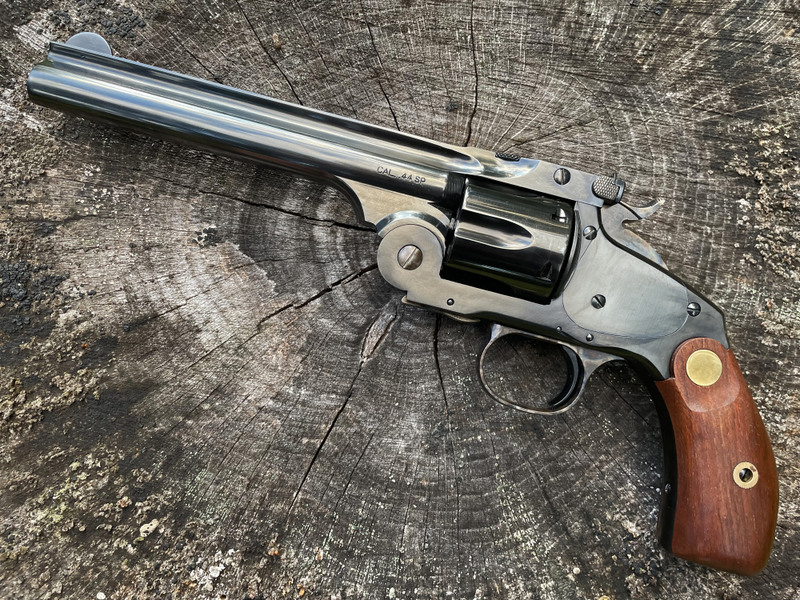
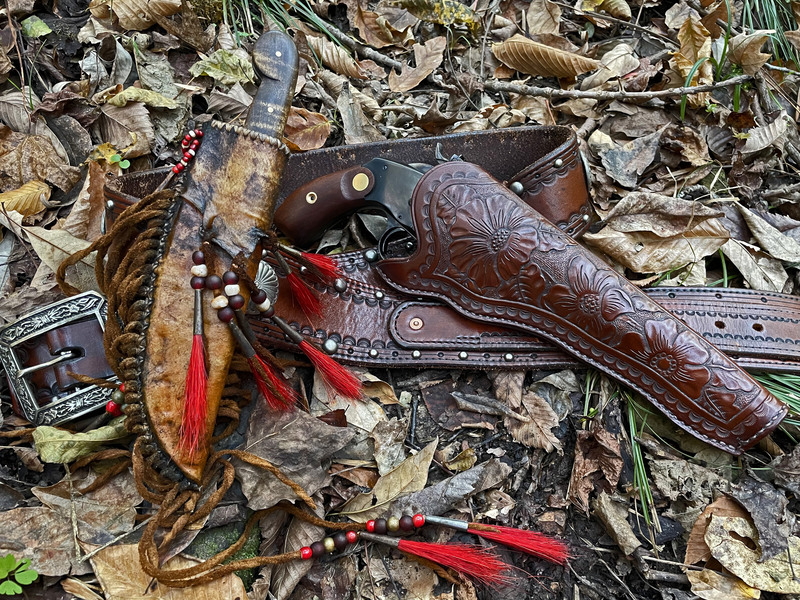


They're pretty cool. I got mine a few years ago when I lived in a neighborhood. Something to shoot in the backyard between trips to the range.I got one of those too. A COVID project I got into when I couldn't get to the gunstore..or rather could't get INTO the gun store. Kind of a cheap gun collection. Guns I knew I'd never actually spring real money for.

l like the 1860 grip also,
Mark_Mark
Member
- Joined
- Jan 9, 2021
- Messages
- 17,960
Your Rigs are so elaborate! looks like your ready for a ceremonyNone of these are in production any more. Glad I got my Frontier when I did, it was the only S&W replica made in .44Spl and they stopped making them shortly thereafter. I carried it in the field a few years.


They're pretty cool. I got mine a few years ago when I lived in a neighborhood. Something to shoot in the backyard between trips to the range.
CraigC
Sixgun Nut
I don't like plain stuff. I did the belt and sheath but haven't really wanted to dive headlong into floral carving. So I found a guy on Etsy that does them for what I consider to be, too cheap.Your Rigs are so elaborate! looks like your ready for a ceremony
Mark_Mark
Member
- Joined
- Jan 9, 2021
- Messages
- 17,960
My sister sold her refinishing on Etsy way to cheap, till she found an audience for her style. (antique furniture) now she priced very high. Lots of good stuff on EtsyI don't like plain stuff. I did the belt and sheath but haven't really wanted to dive headlong into floral carving. So I found a guy on Etsy that does them for what I consider to be, too cheap.
Black M-Z was an earlier version of American Pioneer Powder, distributed by Hodgdon. They have since discontinued it but APP is still in production and used quite a bit by cowboy action shooters who don't like messing with real gun powder's fouling. APP can be cleaned up with just water and the bullets don't require special "soft" lubes like real gun powder.Tell us more. Is this stuff, or its residue, hydroscopic? Can it be loaded and handled like smokeless?
First I've heard of it.
Moon
Dave
Roverguy
Member
- Joined
- Jul 22, 2021
- Messages
- 884
All black powders and their commercially available substitutes are hygroscopic, corrosive if left for any length of time, and clean up in much the same way - with soap and water.Black M-Z was an earlier version of American Pioneer Powder, distributed by Hodgdon. They have since discontinued it but APP is still in production and used quite a bit by cowboy action shooters who don't like messing with real gun powder's fouling. APP can be cleaned up with just water and the bullets don't require special "soft" lubes like real gun powder.
Dave
halfmoonclip
Member
- Joined
- Feb 4, 2011
- Messages
- 2,768
Sigh. That's what I love about Trailboss, which is thin on the ground right now.All black powders and their commercially available substitutes are hygroscopic, corrosive if left for any length of time, and clean up in much the same way - with soap and water.
Moon
Roverguy
Member
- Joined
- Jul 22, 2021
- Messages
- 884
Thin would be an improvement! It’s like 3 years since they ceased distribution ? I believe I heard that a TB replacement of some kind is on the horizon.Sigh. That's what I love about Trailboss, which is thin on the ground right now.
Moon
doubleh
Member
I bought a third model Russian with genuine ivory grips years ago. I never intended to fire it and haven't. It is an interesting design but I find it ungainly with the weight too far forward killing any interest in a repro for me. I still wonder why the Russians wanted that trigger spur.
Driftwood Johnson
Member
All black powders and their commercially available substitutes are hygroscopic, corrosive if left for any length of time, and clean up in much the same way - with soap and water.
I have said this a bazillion times.
Part of the reason Black Powder was so corrosive is because it used to be used with corrosive primers. We don't use corrosive primers any more, and the result is that real Black Powder is far less corrosive than most shooters think. Example: I just cleaned my Uberti Henry a couple of weeks ago. I had fired it in a Cowboy match in June. 44-40 cartridges loaded with Black Powder. Yes, bad on me for letting my lovely Henry sit so long without cleaning it. When BP fouling sits that long it gets kind of fluffy. I cleaned my Henry with the same water based BP solvent that I always use. First I ran a bronze bristle brush down the bore to remove all the fluffy stuff. Then a bunch of patches soaked in my solvent, no different than when I normally clean it. Guess what? absolutely no rust in the bore or anywhere else. The bore still looks just as nice and shiny as it did when I bought the Henry ten years ago.
After a CAS match I never clean my guns as soon as I get home. Just too tired to clean a rifle, shotgun, and two revolvers. I try to clean them within a week, but often go a lot longer. The same result. Modern primers prevent the fouling from being as corrosive as it used to be.
Sometime when you are in a museum, take a look at the lock plate of an antique flintlock rifle vs the lock plate of a percussion rifle. You will see far more rust or pitting around the nipple of the percussion rifle than you will on the lock plate of the flintlock. Because the musket caps used on the C&B rifle had corrosive priming, while the flintlock did not use any priming at all, other than FFFFg powder.
Regarding APP, I have a bottle of it. I have only used it with 38S&W loads for a S&W Perfected Model.
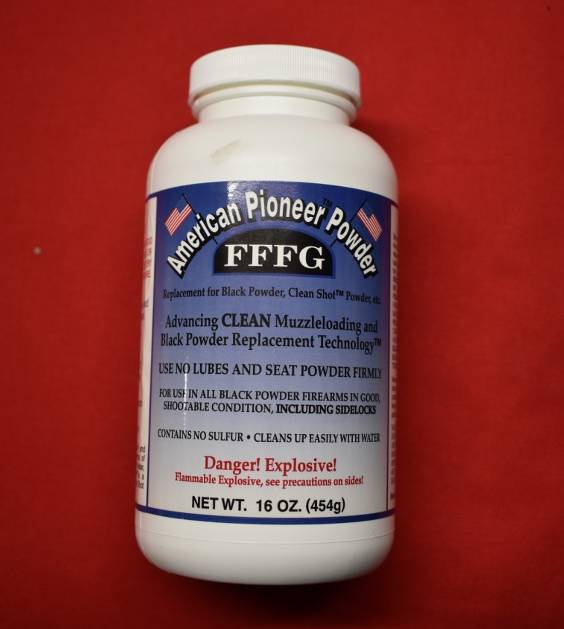
I used the APP because the bullets I was using did not have much of a lube groove, and I did not want to go to the trouble of pan lubing them with BP compatible lube.
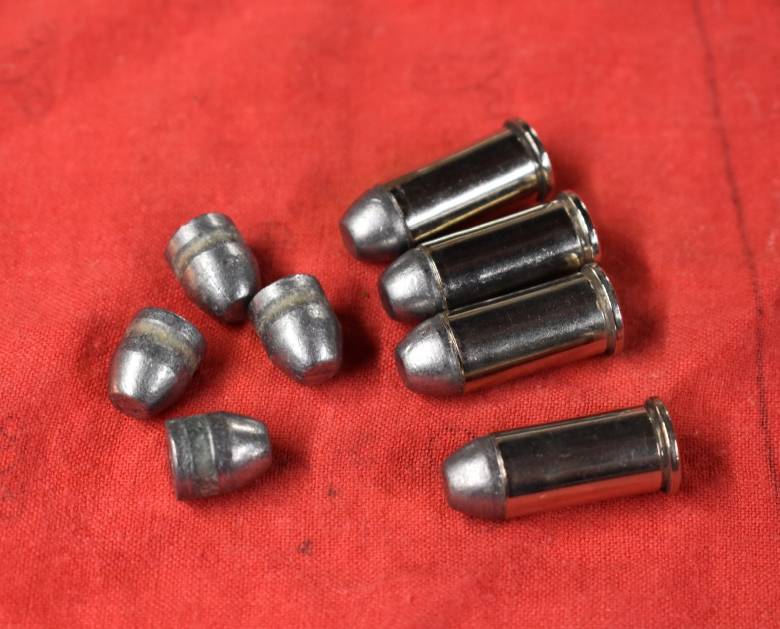
My Perfected model liked the APP cartridges just fine. Cleaned up no different than I clean up any other revolver fired with Black Powder cartridges.
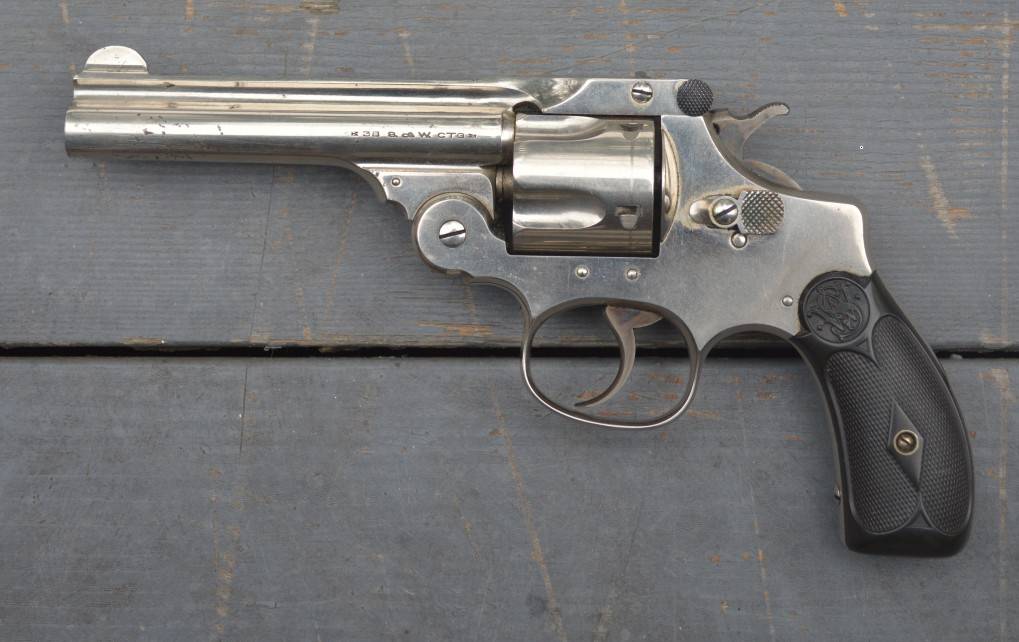
Yup, clean up no different
Driftwood Johnson
Member
Sigh. That's what I love about Trailboss, which is thin on the ground right now.
Moon
I'm sure you know that Trailboss is not a Black Powder substitute.
CraigC
Sixgun Nut
So less with modern cartridge primers than with percussion caps?Part of the reason Black Powder was so corrosive is because it used to be used with corrosive primers. We don't use corrosive primers any more, and the result is that real Black Powder is far less corrosive than most shooters think.
Driftwood Johnson
Member
As far as I know, modern percussion caps are also less corrosive than the originals. But definitely, shooting Black Powder with modern non-corrosive primers, or modern non-corrosive percussion caps makes the fouling less corrosive than in the 'old days'.So less with modern cartridge primers than with percussion caps?
Similar threads
- Replies
- 3
- Views
- 2K


